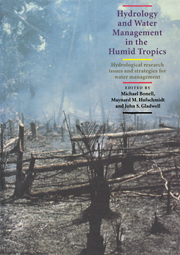 Hydrology and Water Management in the Humid Tropics
Hydrology and Water Management in the Humid Tropics Book contents
- Frontmatter
- Contents
- List of Authors
- Foreword by Federico Mayor, Director-General, UNESCO
- Preface
- Cartographic Credit
- Acknowledgements
- SECTION I INTRODUCTION
- SECTION II HUMID TROPICS SETTING
- SECTION III REGIONAL HYDROLOGY
- SECTION IV PHYSICAL PROCESSES
- SECTION V PHYSICAL PROCESSES – HUMAN USES: THE INTERFACE
- SECTION VI MANAGEMENT ISSUES
- 22 Water Resource Management
- 23 Water Management Issues: Population, Agriculture and Forests – A Focus on Watershed Management
- 24 Urban Water Resources in the Humid Tropics: An Overview of the ASEAN Region
- 25 Urban Water Problems in the Humid Tropics
- 26 Rethinking Urban Water Supply and Sanitation Strategy in Developing Countries in the Humid Tropics: Lessons from the International Water Decade
- 27 Water Resource Management Issues in the Humid Tropics
- SECTION VII APPENDICES
- Place index
23 - Water Management Issues: Population, Agriculture and Forests – A Focus on Watershed Management
Published online by Cambridge University Press: 23 December 2009
- Frontmatter
- Contents
- List of Authors
- Foreword by Federico Mayor, Director-General, UNESCO
- Preface
- Cartographic Credit
- Acknowledgements
- SECTION I INTRODUCTION
- SECTION II HUMID TROPICS SETTING
- SECTION III REGIONAL HYDROLOGY
- SECTION IV PHYSICAL PROCESSES
- SECTION V PHYSICAL PROCESSES – HUMAN USES: THE INTERFACE
- SECTION VI MANAGEMENT ISSUES
- 22 Water Resource Management
- 23 Water Management Issues: Population, Agriculture and Forests – A Focus on Watershed Management
- 24 Urban Water Resources in the Humid Tropics: An Overview of the ASEAN Region
- 25 Urban Water Problems in the Humid Tropics
- 26 Rethinking Urban Water Supply and Sanitation Strategy in Developing Countries in the Humid Tropics: Lessons from the International Water Decade
- 27 Water Resource Management Issues in the Humid Tropics
- SECTION VII APPENDICES
- Place index
Summary
ABSTRACT
In developing countries of the humid tropics, the great pressure of human and livestock population on the land, forest and water resources leads to misuse and mismanagement of land, over-exploitation or clear felling of forests and overgrazing/destruction of grazing lands. Since rainfall is unevenly distributed in space and time, making rainfed agriculture uncertain, humans have turned to irrigated agriculture. Modern large-scale irrigation calls for construction of large dams and reservoirs for storage of water, and networks of canals to deliver water to the farm sites. When water flows overland, it carries varying quantities of suspended sediment (and bed load) which is deposited in the streams, reservoirs, canals and their distributaries, thus reducing the efficient functioning of the reservoirs, turbines and canals.
At the macroscale, the rivers of the world deliver to the ocean 25.7 billion tons of top soil from crop lands in excess of new soil formation. The rivers of Asia – which is very densely populated – are the most burdened with sediment. African rivers, which do not have very dense populations in their catchments, carry the least sediment. The chapter reviews the impact of forest land use on hydrologic disturbance and sediment generation at the microlevel. As long as the forest land use is sustainable and the forest remains intact, the rates of soil erosion and sediment load in streams, and flood peaks remain unchanged or only slightly changed. However, as soon as there is a significant change in any characteristic of the forest, adverse impacts arise from the hydrological disturbances, the erosion and the sedimentation. The intensity of the adverse impacts increases as the forest is converted to grassland and the grassland to cropland.
- Type
- Chapter
- Information
- Hydrology and Water Management in the Humid TropicsHydrological Research Issues and Strategies for Water Management, pp. 496 - 525Publisher: Cambridge University PressPrint publication year: 1993
- 3
- Cited by


